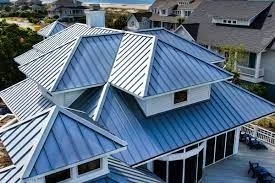It's no secret that sustainable building design is becoming increasingly popular. And while there are many different aspects to consider when designing a sustainable structure, one important consideration is the type of roofing material you use. By relying on a metal roofing contractor, like Stahl Roof Systems, you can make sure that you get the maximum benefits from metal roofing.
It is important to note that metal roofing has long been recognized as one of the most sustainable roofing options available, and its role in sustainable building design is only growing. Let's explore this concept in detail.
What Is Sustainable Building Design?
Sustainable building design incorporates a range of strategies and practices to minimize harm to the environment. This includes energy-efficient windows, smart irrigation systems, and high-performance materials that require fewer resources.
Metal roofing is an important part of sustainable building design because it requires less energy to produce, lasts several decades with minimal maintenance, and is 100% recyclable at its end of life.
Furthermore, metal roofs have superior wind resistance due to their interlocking panels and bond well in extreme temperatures, making them perfect for harsh climates. With metal roofing, builders can achieve higher performance levels while keeping environmental impact to a minimum.
Benefits Of Metal Roofing In Sustainable Building Design
Metal roofing is becoming an increasingly popular choice for commercial buildings looking for sustainable design. It has the added benefits of being 100% recyclable and is incredibly durable, with some metal roofs offering a lifespan of up to 70 years!
The following are the major benefits of metal roofing:
Energy Efficiency
Metal roofing has high reflectivity properties that help to reduce heat absorption and lower cooling costs. Unlike traditional roofing materials such as asphalt shingles, which can absorb and radiate heat, metal roofing reflects the sun's rays. It reduces the amount of heat that is transferred into the building.
This makes it ideal for use in hot climates where air conditioning is necessary. Moreover, edmonton metal roofing can also be combined with insulation materials to improve its insulating properties, further reducing energy consumption.
As a result of these properties, commercial buildings fitted with metal roofing systems have reduced cooling needs in summer and can also assist in reducing heating energy demands in the winter months.
Water Conservation
Another benefit of metal roofing is its ability to collect rainwater for reuse. Metal roofing can be designed with a system that collects rainwater and directs it to a storage tank. This water can then be used for irrigation or other non-potable purposes, reducing the need for municipal water and promoting sustainable water practices.
Durability
Metal roofing has a longer lifespan than traditional roofing materials, making it an excellent investment for sustainable building design. Metal roofing can last up to 50 years or more, while traditional roofing materials typically have a lifespan of 20 to 30 years. This means that metal roofing will not need to be replaced as frequently, reducing waste and the environmental impact of construction.
Moreover, commercial metal roofs are designed to withstand strong weather conditions and provide improved airtightness, which effectively seals off the building space from outside air infiltration and makes the interior space more comfortable.
Recyclability
At the end of its lifespan, metal roofing can be easily recycled, making it an eco-friendly option for sustainable building design. Unlike traditional roofing materials that end up in landfills, metal roofing can be melted down and reused to create new products. In fact, many metal roofing manufacturers use recycled materials in their products, further reducing their environmental impact.
Why Incorporate Metal Roofing In Sustainable Building Design?
An important aspect of sustainable building design is incorporating commercial metal roofing. Metal roofs require minimal maintenance, sustain their structural integrity over the long term and can reduce heating and cooling costs.
Moreover, they are also a low carbon footprint product, with most commercial metal roofing using recycled materials, making them an environmentally-friendly choice. Due to their reflective qualities, commercial metal roofing systems can contribute to LEED certification in commercial buildings and help reduce what is commonly referred to as the "heat island effect" caused by standard residential asphalt roofs.
Therefore, companies, as well as individuals looking for green solutions for commercial or residential rooftop construction, should consider metal roofing as a cost-effective and sustainable option.
Conclusion
Overall, metal roofing is becoming an increasingly popular choice for different types of buildings due to its numerous sustainability benefits. Metal roofing helps commercial building owners achieve their sustainability goals by being renewable and recyclable, offering prolonged longevity with only minimal maintenance, and creating a cool roof layer that reflects solar radiation and reduces cooling costs.
Furthermore, commercial metal roofing is known for its stylish look while also providing energy savings through increased efficiency in heating and cooling systems. All these advantages truly make commercial metal roofing an ideal choice for sustainable building design.


